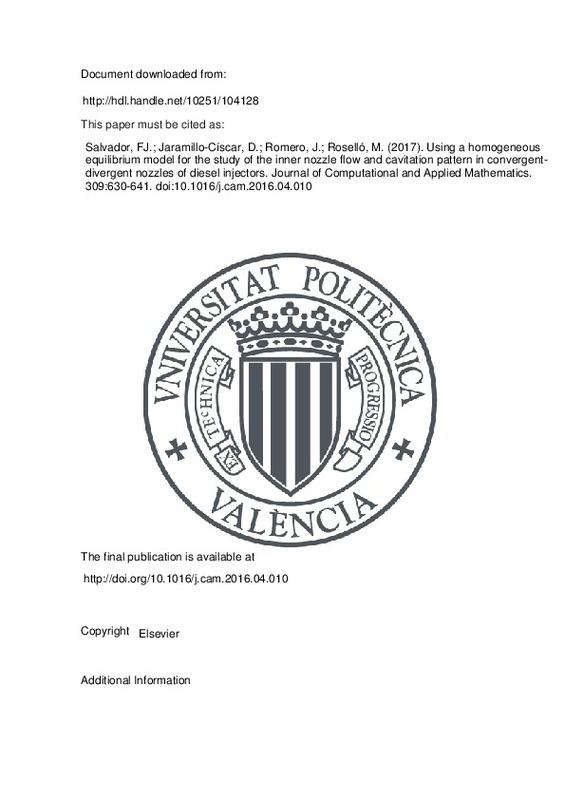JavaScript is disabled for your browser. Some features of this site may not work without it.
Buscar en RiuNet
Listar
Mi cuenta
Estadísticas
Ayuda RiuNet
Admin. UPV
Using a homogeneous equilibrium model for the study of the inner nozzle flow and cavitation pattern in convergent-divergent nozzles of diesel injectors
Mostrar el registro sencillo del ítem
Ficheros en el ítem
| dc.contributor.author | Salvador, Francisco Javier
|
es_ES |
| dc.contributor.author | Jaramillo-Císcar, David
|
es_ES |
| dc.contributor.author | Romero, José-Vicente
|
es_ES |
| dc.contributor.author | Roselló, María-Dolores
|
es_ES |
| dc.date.accessioned | 2018-06-15T04:23:32Z | |
| dc.date.available | 2018-06-15T04:23:32Z | |
| dc.date.issued | 2017 | es_ES |
| dc.identifier.issn | 0377-0427 | es_ES |
| dc.identifier.uri | http://hdl.handle.net/10251/104128 | |
| dc.description.abstract | [EN] In this paper, the behaviour of the internal nozzle flow and cavitation phenomenon are numerically studied for non-conventional Diesel convergent-divergent nozzles in order to assess their potential in terms of flow characteristics. The used nozzles differs each other in the convergence-divergence level of the orifices but all of them keep the same diameter at the middle of the nozzle orifice. The calculations have been performed using a code previously validated and able to simulate cavitation phenomenon using a homogeneous equilibrium model for the biphasic fluid and using a RANS method (RNG k-ε) as a turbulence modelling approach. For the simulations, one injection pressure and different discharge pressures were used in order to assess the characteristics of nozzles for different Reynolds conditions involving cavitating and non-cavitating conditions. The comparison of the nozzles has been carried out in terms of flow characteristics such as mass flow, momentum flux, effective velocity and other important dimensionless parameters which help to describe the behaviour of the inner flow: discharge coefficient (Cd), area coefficient (Ca) and velocity coefficient (Cv). Additionally, the nozzles have been compared in terms of cavitation inception conditions and cavitation development. The study has shown a high influence on the results of the level of convergence-divergence used in the nozzles. In these nozzles, the vapour originated from cavitation phenomenon came from the throttle of the orifice at the midpoint, and it extended along the whole wall of the divergent nozzle part towards the outlet of the orifice. The main results of the investigation have shown how the different geometries modify the cavitation conditions as well as the discharge coefficient and effective velocity. In particular, the nozzle with highest convergence-divergence level showed cavitation for all the tested conditions while for the nozzle with lowest convergence-divergence level, the cavitation phenomenon could be avoided for high discharge pressures. Additionally, the nozzle with highest convergence-divergence level showed the lowest discharge coefficient values but similar effective injection velocity than the nozzle with lowest level of convergence-divergence level despite of its higher orifice outlet area. | es_ES |
| dc.description.sponsorship | This work was partly sponsored by ‘‘Ministerio de Economía y Competitividad’’ of the Spanish Government, in the frame of the project ‘‘Estudio de la interacción chorro-pared em condiciones realistas de motor’’, Reference TRA2015-67679-c2-1- R. This support is gratefully acknowledged by the authors. Mr. Jaramillo’s thesis is supported by ‘‘Conselleria d’Educació, Cultura I Esports’’ of ‘‘Generalitat Valenciana’’ through the program ‘‘Programa VALI+D para investigadores en Formación’’, Reference ACIF/2015/040. The authors would like to express gratitude for the computer resources, technical expertise and assistance provided by the Universidad de Valencia relating to the use of the supercomputer ‘‘Tirant’’. | |
| dc.language | Inglés | es_ES |
| dc.publisher | Elsevier | es_ES |
| dc.relation.ispartof | Journal of Computational and Applied Mathematics | es_ES |
| dc.rights | Reconocimiento - No comercial - Sin obra derivada (by-nc-nd) | es_ES |
| dc.subject | Cavitation | es_ES |
| dc.subject | OpenFOAM | es_ES |
| dc.subject | Internal flow | es_ES |
| dc.subject | Diesel injector | es_ES |
| dc.subject | Nozzle | es_ES |
| dc.subject | CFD | es_ES |
| dc.subject | Convergent-divergent nozzle | es_ES |
| dc.subject.classification | MATEMATICA APLICADA | es_ES |
| dc.subject.classification | MAQUINAS Y MOTORES TERMICOS | es_ES |
| dc.title | Using a homogeneous equilibrium model for the study of the inner nozzle flow and cavitation pattern in convergent-divergent nozzles of diesel injectors | es_ES |
| dc.type | Artículo | es_ES |
| dc.identifier.doi | 10.1016/j.cam.2016.04.010 | es_ES |
| dc.relation.projectID | info:eu-repo/grantAgreement/MINECO//TRA2015-67679-C2-1-R/ES/ESTUDIO DE LA INTERACCION CHORRO-PARED EN CONDICIONES REALISTAS DE MOTOR/ | es_ES |
| dc.relation.projectID | info:eu-repo/grantAgreement/GVA//ACIF%2F2015%2F040/ | es_ES |
| dc.rights.accessRights | Abierto | es_ES |
| dc.date.embargoEndDate | 2019-01-01 | es_ES |
| dc.contributor.affiliation | Universitat Politècnica de València. Departamento de Máquinas y Motores Térmicos - Departament de Màquines i Motors Tèrmics | es_ES |
| dc.contributor.affiliation | Universitat Politècnica de València. Departamento de Matemática Aplicada - Departament de Matemàtica Aplicada | es_ES |
| dc.description.bibliographicCitation | Salvador, FJ.; Jaramillo-Císcar, D.; Romero, J.; Roselló, M. (2017). Using a homogeneous equilibrium model for the study of the inner nozzle flow and cavitation pattern in convergent-divergent nozzles of diesel injectors. Journal of Computational and Applied Mathematics. 309:630-641. https://doi.org/10.1016/j.cam.2016.04.010 | es_ES |
| dc.description.accrualMethod | S | es_ES |
| dc.relation.publisherversion | http://doi.org/10.1016/j.cam.2016.04.010 | es_ES |
| dc.description.upvformatpinicio | 630 | es_ES |
| dc.description.upvformatpfin | 641 | es_ES |
| dc.type.version | info:eu-repo/semantics/publishedVersion | es_ES |
| dc.description.volume | 309 | es_ES |
| dc.relation.pasarela | S\317355 | es_ES |
| dc.contributor.funder | Generalitat Valenciana | es_ES |
| dc.contributor.funder | Ministerio de Economía, Industria y Competitividad | es_ES |







![[Cerrado]](/themes/UPV/images/candado.png)

